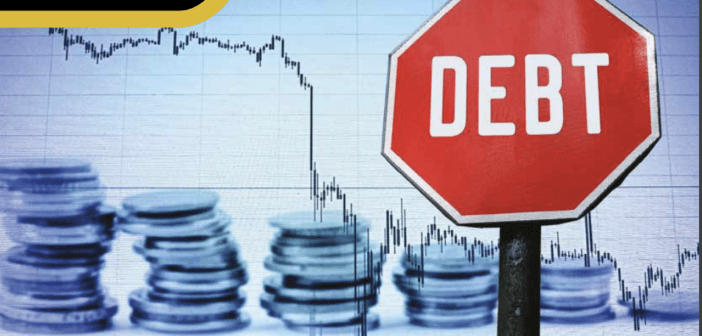By Derek Mutiso
Suggestions for Sustainable Economic Growth
As several nations in Sub-Saharan Africa teeter on the verge of debt crisis, the sustainability of debt in Africa continues to be a major cause for debate among economic experts. The Kenyangovernment has so far shown resolve in steering the economy through soaring inflation, drought,and a hefty debt load.
The unsettling economic situation of our African counterparts like Ghana, Zambia, and Malawiwho have had to restructure their debt entirely to avoid total default, has demonstrated the fragility of other economies on the continent. It has led global financial institutions, including the World Bank and the International Monetary Fund (IMF) to emphasize the urgent need for fiscal reforms across the board.
In May 2023, The World Bank Group authorized a transfer of Kes138.6 billion ($1 billion) to Kenya, as part of its development policy operations. Kenya also finalized an agreement with the International Monetary Fund to receive Kes56.8 billion ($410 million). The IMF and World Bank stepped into the shoes of China, which funded most of the previous regime’s infrastructure projects. China has been Kenya’s biggest creditor since 2015, but this changed after Beijing decided to re-evaluate its policy on lending to Africa in 2021, choosing to focus on lending toSmall and Medium Enterprises (SMEs), environment-friendly projects, and private investment flows rather than large infrastructure projects.
To secure the much-needed Sh138.6 billion World Bank facility, which will ease the cash flow crisis and boost Kenya’s diminishing foreign exchange reserves, the National Treasury listed several probable reforms which included:
• The issuance of new electricity tariffs by the Energy and Petroleum Regulatory Authority to ensure sufficient revenues for Kenya Power.
• The World Bank suggested expanding the tax base, leading to the introduction of new regulations and proposals in the Finance Bill 2023. The tax base expansion efforts include; targeting the informal sector and revising the turnover tax threshold.
• The Treasury has created the Financial Inclusion Fund, known as the Hustler Fund, to improve credit access for underserved segments such as small and microenterprises.
• Replacing the Kes9Trillion debt ceiling with a debt anchor of 55 percent of GDP in present value terms to ensure adequate provision for the 2023/24 budget deficit.
• Last year, President William Ruto announced the government’s intention to privatize a minimum of five state-owned corporations in the current year. This move has been included by the Treasury as part of the action plans to secure financing from the World Bank. To streamline the privatization process, proposed changes to the Privatization Act have been submitted. As a result of the government’s withdrawal from commercial investments, the Exchequer will assume a central role in the disposal of assets.
Kenya is currently facing some challenges in its debt management. The nation’s debt-service-to-revenue ratio stands at 47.9%, reflecting the strain on our ability to meet our debt obligations using available revenue. Kenya’s debt-to-GDP ratio rose to 63.0% in 2022, surpassing the International Monetary Fund’s recommended threshold of 50.0% for developing countries by a significant margin of 13.0%. Experts are hopeful, however, that if the government can implement its revenue collection targets, then the situation will improve. To secure a more promising economic outlook, the government needs to take decisive action to reduce these figures and address the growing revenue mismatch that contributes to fiscal deficits. Implementing effective fiscal consolidation measures is crucial for Kenya to regain control of its debt situation and fostereconomic stability.
Kenya has also recently received credit downgrades from credit agencies such as Fitch and S&P. While these downgrades represent a setback, they also present an opportunity for the nation to re-evaluate its borrowing strategies and make strategic adjustments. By focusing on enhancing liquidity and managing its debt profiles more efficiently, Kenya can begin to restore investor confidence, paving the way for renewed access to favorable financing options in international markets.
Successfully addressing these pressing issues is vital for Kenya’s long-term growth and development. By reducing its debt burden and effectively managing its fiscal situation, the country can establish a solid foundation for future economic prosperity. This will not only instill confidence among domestic and international investors but also create an environment conducive to sustainable growth and advancement across various sectors of the economy.
The current administration, which took over last September, has pledged to lower its rate of borrowing, with foreign loans committed for the new budget falling to Ksh313.8 billion ($2.3 billion) from the current Ksh326 billion ($2.4 billion). Kenya also has a $2 billion Eurobond which will mature in June 2024, and some financial experts have predicted that the country faces a considerable risk of debt distress next year, but in a statement made to Reuters, the central bank governor maintained that the government was “quite relaxed” about it.
Overall, Kenya’s debt challenges present a call to action. With prudent fiscal management and strategic reforms, we can navigate these challenges and pave the way for a brighter future. A good starting point is to look back into the past and identify the drivers that accelerated growth in Kenya’s public debt.
What are the catalysts behind Kenya’s historical public debt growth?
The growth of Kenya’s public debt over the past ten years can be attributed to several key drivers.
Firstly, the rising costs of servicing the debt have placed substantial strain on debt sustainability and the value of the Kenyan shilling. The continuous accumulation of external debt and currency depreciation have driven these servicing costs higher. To meet these obligations and adhere to borrowing covenants, the government has had little choice but to widen the tax net.
Secondly, the budget shortfall has persistently averaged 8.1% of GDP for the past decade. Additional domestic borrowing of Kes1.0 trillion and Kes349.3 billion from external funding was required to cover this shortfall.
Another contributing factor is the persistent shortfall in revenue collections by the Kenya Revenue Authority (KRA). Despite witnessing significant growth in tax revenues, the KRA has consistently fallen short of its targets. To bridge these revenue gaps and cover budget deficits, both local and external borrowing has been utilized, leading to a continuous expansion of the country’s debt profile.
Additionally, the government’s guarantee of loans to state corporations, totaling Kshs 164.6 bn as of December 2022, has added pressure to engage in excessive spending. Despite underperforming state corporations, the government has had to resort to borrowing to finance these guaranteed loans.
The combination of these factors has resulted in significant growth in Kenya’s public debt over time, highlighting the challenges faced in managing debt sustainability and fiscal stability.
What do high debt levels mean for us and our economy?
Amidst the headwinds of geopolitical tensions, supply chain disruptions, a tepid business environment, and surging inflationary pressures, the global economic slowdown has coerced a multitude of developing nations, Kenya included, into resorting to heightened borrowing endeavors as a means to safeguard their economies. This prolonged reliance on borrowing has engendered a disquieting surge in accumulated debt, unfurling a cascade of consequences for Kenya’s economic fabric.
• Burdened by debt obligations denominated in foreign currencies, Kenya faces the mounting challenge of high costs associated with servicing its debt. Compounded by the depreciation of the local currency, the government finds itself compelled to resort to increased taxation to fulfill its debt obligations
• As Kenya grapples with high levels of debt, the cost of securing additional borrowing is expected to rise significantly. Lenders, cognizant of the heightened risk of debt distress, are likely to demand higher interest rates for new loans. This elevated borrowing cost poses a significant challenge for the private sector, limiting its access to capital and impeding its ability to drive economic growth. The resulting constraints on private sector activities have far-reaching implications, hindering investment, innovation, and overall economic expansion in the country.
Despite the challenges, financial forecasts indicate a promising trend in the budget deficit, with expectations of a 2% reduction to 6.1% by the conclusion of the fiscal year 2022-2023. We can only remain hopeful that this downward trajectory will persist in the years ahead, allowing the current regime to achieve its ambitious target of attaining a budgetary surplus within its third year in office.
What can be done to improve Kenya’s debt position?
There is extensive literature on debt management that has been compiled by researchers and scholars from around the world. This literature presents governments with a range of actionable steps to get themselves out of a debt conundrum. Apart from the measures the government is taking, here are a few other options that stand out as potential pathways for the Kenyangovernment to pursue:
1. Curbing Recurrent Expenditure: Kenya’s expenditure composition leans heavily towards recurrent expenditure, particularly public wages. To free up resources, there is a need to reduce recurrent expenditure and rebalance the expenditure mix. This will help alleviate the debt burden. During the 1990s, Canada successfully tackled its nearly double-digit budget deficit through a combination of profound budget cuts, reducing the deficit to zero within three years and slashing public debt by one-third within five years. Notably, Canada achieved these significant results without resorting to tax increases. The fear of voter dissatisfaction and subsequent electoral consequences often hinders politicians from mustering the necessary political will to enact essential budget reductions.
2. Boost Exports: The government should adopt a strategic approach to boost exports and revitalize the manufacturing sector. Implementing export-friendly policies would not only enhance the current account but also act as a stabilizing force for the exchange rate, thereby curbing the increase of foreign-denominated debt in the face of shilling depreciation.
3. Kenya should give attention to strengthening its capital markets to make it easier for investors to take on development initiatives. The country’s capital market is now underfunded and eclipsed by the banking industry, which has amassed significant deposits in contrast to the comparatively little amount raised by Collective Investment Schemes. Increased assistance and funding are required to resolve this, and realize the potential of the capital markets. Kenya will increase investor interest and promote economic expansion, by strengthening the structure of its capital market.
Is debt restructuring necessary?
Chair of the President’s Economic Advisory team, David Ndii, expressed caution against initiating debt restructuring in Kenya at present in an interview with a local daily. Debt restructuring involves renegotiating loan terms to facilitate easier repayment and mitigate the risk of default. Ndii emphasized that Kenya’s debt is indeed manageable and repayable. He warned that embarking on debt restructuring now could lead to prolonged and complex negotiations, similar to the situations faced by countries like Zambia and Ghana, diverting attention away from other crucial priorities for the next 3-4 years.
Ndii clarified the distinction between insolvency and illiquidity, stating that debt restructuring is necessary when a country is insolvent, meaning it cannot meet its financial obligations. However, Ndii argued that Kenya is not insolvent, as its debt is payable and can be financed through various means such as treasury bills and bonds. The head of the International Monetary Fund’s Africa Department, Abebe Aemro Selassie, echoed Ndii’s views when he stated that Kenya is not expected to pursue debt restructuring, as reported during the IMF and World Bank spring meetings.
By implementing these strategic measures, such as enhancing fiscal consolidation, promoting capital markets, and improving the country’s exports, Kenya can effectively address its debt challenges and pave the way for sustainable economic growth.
These actions will not only alleviate the burden of high debt levels but also foster investor confidence, stimulate private sector participation, and unlock development opportunities. With prudent financial management and a focus on long-term stability, Kenya can position itself for a brighter future of economic prosperity and progress.
The writer is a business writer and project coordinator, Omeriye Foundation.




